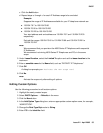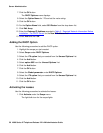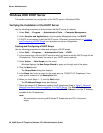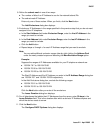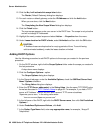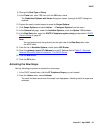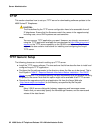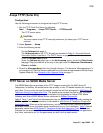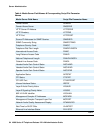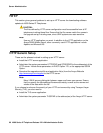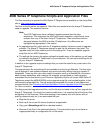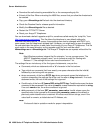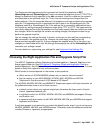
TFTP
Issue 2.2 April 2005 63
Avaya TFTP (Suite Pro)
Configuration
Use the following procedure to configure the Avaya TFTP server:
1. Run the TFTP Suite Pro Server by selecting:
Start
-->Programs-->Avaya TFTP Server-->TFTPServer32.
The TFTP server starts.
!
CAUTION:
CAUTION: You must restart Avaya TFTP manually whenever you reboot your TFTP server
machine.
2. Select System
-->Setup.
3. Enter the following values:
On the Outbound tab page: 1.
The Outbound path is the TFTP file path as recorded in Table 2: Required Network
Information Before Installation - Per DHCP Server on page 48.
Check the Enable Path options.
Under the Options tab page: turn on the No Incoming option. Under the Client Limits
tab page: Drag the slide bar all the way to the right to set the Maximum Simultaneous
Clients to infinite.
4. Place the 46xxupgrade.scr file in the file path directory. The filename “46xxupgrade.scr” is
an example only. Use the filename obtained from the material downloaded from the Avaya
Support Web site. See Contents of the Upgrade Script
on page 71.
TFTP Server on S8300 Media Server
The S8300 Media Server provides all the TFTP support required for the 4600 Series IP
Telephones. In addition, the media server has an easy to use, PC-based interface for creating
script files. Thus, you do not need to manually create the text files discussed in 4600 Series IP
Telephone Scripts and Application Files. The media server creates the files for you. For more
information about the media server, see Installation and Upgrades for Avaya G700 Media
Gateway and Avaya S8300 Media Server, mentioned in Related Documents
.
Table 6
, Table 7, and Table 8 list the parameters you can administer when manually creating the
TFTP script file. Manual administration is discussed in 4600 Series IP Telephone Scripts and
Application Files. When using the media server, you do not need to worry about the specific
parameter names, since the media server handles that for you. For information, Table 4
lists the
parameter names from 4600 Series IP Telephone Scripts and Application Files
. Table 4 also
indicates the corresponding field name from the media server’s TFTP/HTTP server application.
Any limits, restrictions, etc. on the parameters are built into the media server.



